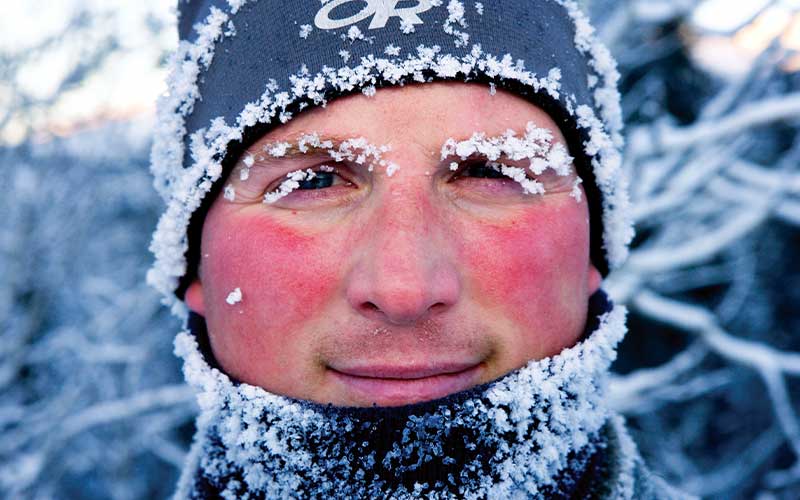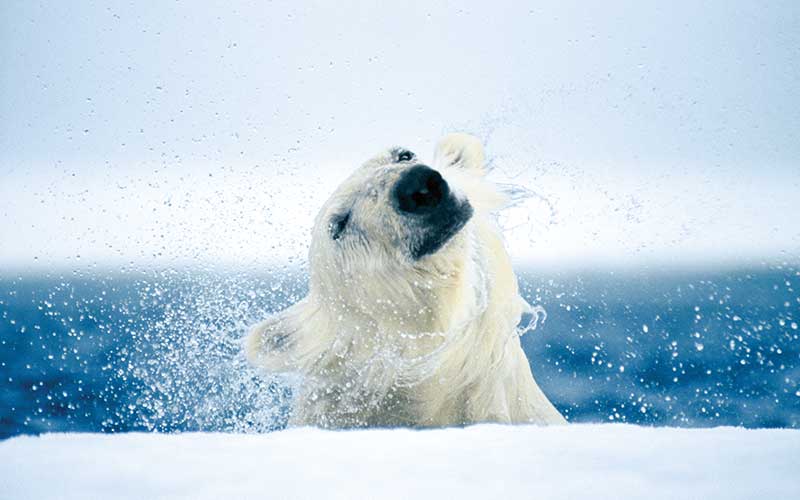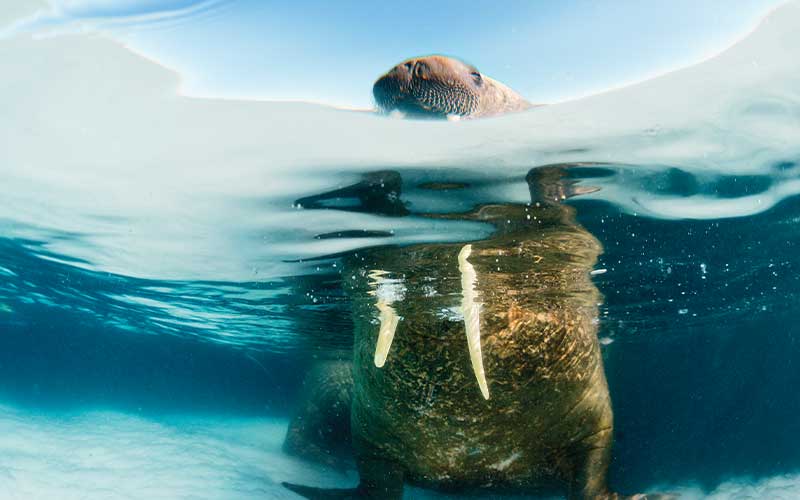I always view underwater photographs like I’m judging a springboard diving competition. I consider the technical excellence of the photograph, but then there is a multiplier applied by degree of difficulty. A really good shot of a blue-striped grunt in Key Largo, Fla., might get a 10 for execution, but on a degree-of-difficulty scale of 1 to 5, it is probably only a 1; so at best, it’s a 10-point shot.
But consider a shot of a leopard seal in the Antarctic. Just getting to the location boosts the degree of difficulty, as does the dive into frigid water. Then add the danger of a marine mammal that’s 11 ft (3 m) long, with massive teeth and a somewhat belligerent attitude. Now imagine that angry leopard seal is just 2 inches from the dome port, and add the presence of mind to get the lighting just right. This is the highest degree of difficulty combined with superb technical execution, clearly a 50-pointer!
It was this specific shot that stopped me flipping through the pages of National Geographic to study the image with respect and fantasize about what transpired the day it was taken. I wanted to hear more about how such a shot was made and how photographs of our polar regions came to be Paul Nicklen’s specialty. Here’s his story.

An Interview with Paul Nicklen
Paul Nicklen’s direction in life was forged by the time he was 4, when his family moved to Baffin Island in the Canadian Arctic. Growing up in a small Inuit settlement without “distractions” like telephones, TVs and computer games, Nicklen learned the secrets of the regional wildlife. He also developed a fundamental skill for his future career: patience.
With his formative years immersed in an environment where he saw his first polar bear at age 5, Nicklen was certain he’d be doing something with or for animals when he grew up, and he went to the University of Victoria with that objective in mind. After graduation he worked as a wildlife biologist for four years in the Northwest Territories, with a specialty in lynx, grizzly bears and polar bears. Yet he could never shake the sense that his life’s path should be as a photographer.
Nicklen’s mission as a photojournalist was to make a difference for Arctic wildlife. He wanted to tell their stories and enhance their protection. Fast forward through 10 very lean years honing his craft in the Northwest Territories and paying the bills by guiding tourists to polar bear photo-ops in Churchill, Manitoba. On one expedition, he had the good fortune to spend time with National Geographic photographer Flip Nicklin (no relation), who saw a passion and technical excellence in Nicklen’s photos and offered to mentor the younger man. Following the successful completion of a trial assignment as back-up shooter on an article about stellar sea lions and salmon in 2001, Nicklen got his big break with National Geographic and has never looked back.

SF: What’s it like to go out on a big project in the Arctic?
PN: These shoots are for long periods of time — three to four months usually. But that’s only the time of field immersion. Before that there are several months of research and logistical organization, and then when I get home there is the work with my editor in Washington, D.C., going through what might have been the 50,000 RAW photos I shot, which have now been edited down to maybe 6,000 by my editor, which we then go through together to come up with the 60 that we show the upper echelons of National Geographic. From there we all get it down to somewhere in between 10 and 20 pictures that tell the story. It is so essential to work with a good editor because we are so close to the stories and cannot always see things clearly. My editor will often see something totally different than what I saw. Maybe there’s some detail that’s cogent to the overall theme of the piece, but maybe I didn’t see it. So sitting in that darkened room projecting the selects from four months of my life is really interesting. If there’s something you feel passionate about, you have to speak up and be convincing. It happens fast, and the article begins to take on its own life.
SF: These have to be brutal conditions. What camera gear do you take on location?
PN I use Canon EOS-1Ds Mark III camera bodies, always at least two of them, and a variety of lenses from ultra-wide to telephoto. For my underwater work I use a pair of Seacam housings, either an S180 or S45 magnified viewfinder and the mineral glass domes, which are very good, but leopard seal teeth can definitely scratch them! It seems I wait for months for just the right marine life encounter, and then when it happens, it happens so quickly. I need strobes I can depend on, with good power and very quick recycle time. For this I prefer my Ikelite strobes, DS125 and DS160s these days.
Because I’m a digital photographer, I need power in the field, so a Honda portable generator goes with me. I have a Mac laptop so I can look at my images on location, but really my only piece of critical software is Photo Mechanic. The 1Ds Mark III files are very big, but Photo Mechanic builds views from the embedded JPGs and is therefore very fast. I can embed metadata that may be crucial to editing later and easily renumber the files. But really that’s about all I’m allowed to do anyway, because National Geographic wants to see the whole shoot in RAW, without any manipulation or editing.

SF: That must be a little intimidating, to have the good and the bad out there for someone else to see. I know my work can always stand a good dose of editing before I turn it over to the client.
PN Yeah, but that is the National Geographic way. In the old days we had to send in all of our rolls of film unprocessed. Then the photographers would never even see their work until they went to Washington for their first edit. With digital, at least we get to see the images, even if we aren’t allowed to delete or modify a single frame.
Remember, we are telling a story. For you as a stock photographer, maybe it is about megafauna, the sexy characteristics of animals that are easy to love, like a bottlenose dolphin or even a great white shark. For me, there is a compelling story I have to tell. The reality is that the polar regions are warming twice as fast as anyone thought possible. In seven to 10 years, the Arctic pack ice will be gone in the summer. No one imagined that would happen in our lifetimes. Maybe part of that story is some obscure amphipod that is critical to the food chain.
Certainly, that’s not megafauna and will never sustain a career as a stock photographer, but it is a crucial part of a story that has to be told. That’s what I do. I define what the story is and then capture the images that illustrate the concept.
My recent narwhal story is an example about combining the good with the bad. I don’t want to hide the truth of a subject behind a pretty picture. The realiy is that narwhals are a very poorly managed species, as they were being wiped out by bad hunting practices to get the ivory. To show only beautiful photos of what is an admittedly fascinating subject may do more harm than good. Sometimes there is blood and death behind my scenes, but I’m obligated to tell that story too.
SF: I know you said you spend months preparing for a project, but how do you do that?
PN I talk to other photographers, researchers and tour operators (assuming I’m going somewhere where there are tours). Despite all the preparation, it is all about being nimble and proficient in the field. I can spend a month camped on pack ice, eating seal meat and waiting for just the right light to break. For me it’s about three essential bullet points: passion, time and patience. Without the right amount of any of the three, the story can’t happen, at least not to its potential.

SF: What do you think separates you from the other shooters out there?
PN I can say what other people have told me I do differently. They say I am a street photographer for the underwater world. I get dangerous animals close, personal and intimate. Take the leopard seal, for example. That was a calculated risk based on the knowledge of my colleague Goran Ehlme of how this animal would likely react to me while it was hunting. It got a little more animated than I predicted, but I never felt I was in grave danger. On a recent elephant seal shoot in Antarctica, it was just the opposite!
I was on location for an article that will run in the December 2009 issue of National Geographic, and I was swimming along in the shallows intending to do a little wide-angle work with my housed camera. You have to understand this was breeding season, and bull seals have just two things on their minds — breed or kill anything that gets in the way of their breeding. Understand also that a bull seal is 18 ft (5 m) long and about the same weight as a Ford F350 truck — 8,000 lbs (362 kg). With visibility only 3 ft (1 m), I have to get close — too close apparently, because this bull reared up on his front flippers and crashed down on me, wanting to obliterate me by crushing me against the bottom. I rolled away from the first attack and then had to keep shoving my dome in his mouth to keep him from sinking his 4-inch-long (10 cm) canines into me. Lost another dome to that one, but that was the least of my worries at the time. I really thought I might die. I kept rolling away from the attacks and fortunately kept my mask on and wits about me. I kept hollering for help, and finally my assistant, who was several hundred yards up the beach, heard the commotion and distracted the seal long enough for me to escape.
That was a close one. But for my friend it was even closer on a recent project. We’d been together for a month on location just 500 miles (805 km) from the North Pole, photographing polar bears. With a kind of dark humor we joked about the hazards of where we were, but we also spoke of how lucky we were to be immersed in one of the most beautiful and wild places on earth. I had just barely gotten home from assignment when I got the word that he had fallen through the ice on his machine and died of hypothermia. That’s the sobering reality of where we go and what we do.
© Alert Diver — Q4 Fall 2009